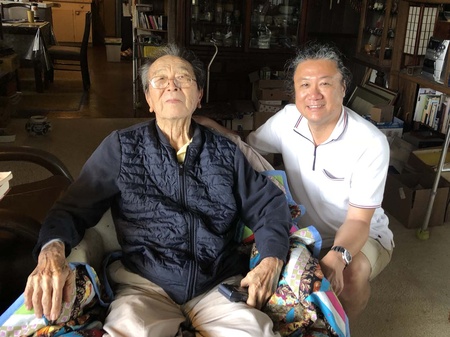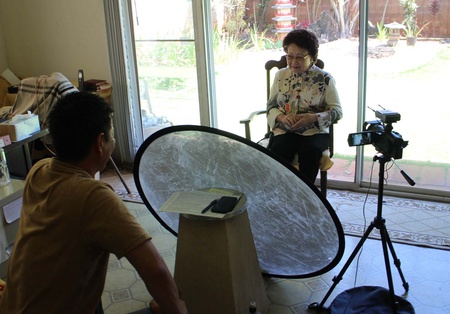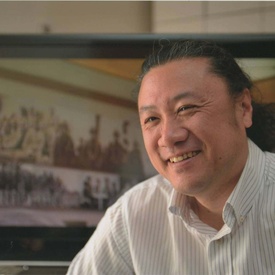Movie producer Hiroyuki Matsugen Matsumoto’s 2021 documentary, Okagesama de - Hawaii Nikkei Women’s Trajectory is his latest effort to preserve and tell the stories of Japanese immigrants in Hawaii. This follows Go for Broke! Memories of Hawaii Japanese Nisei which was completed in 2012. These two films describe the journey of Japanese immigrants from hardship and triumph to their lasting influence on Hawaiian and American culture.
Interviewed via email, Matsumoto wrote that he was born in Miyazaki Prefecture in 1964 and raised in Gifu Prefecture, where he worked as a copywriter, TV commercial planner, and video producer for an advertising company until 2008. A personal incident, however, directed his focus toward Hawaii.
Matsumoto wrote:
It’s very difficult to explain how I got started making documentaries. It is a long story.
I had a friend in Kumamoto prefecture who was a calligrapher. He died of cancer at the end of 2007. Three months before he passed away, he told me his dream that he wanted to introduce his works in Maui. I made plans to go to Maui for the first time three days after this call. So I created a profile of my friend and made an appointment with the Kumamoto Kenjinkai in Maui where I met the organization’s president and her husband. They were Nisei and when I explained my friend’s dream, they said, “If your friend has a solo exhibition, we will be happy to help.”
The president of the Maui Kumamoto Kenjinkai was also involved in the establishment of the Nisei Veterans Memorial Center and the Kansha Preschool, also located on Maui. Matsumoto wrote, “I thought it would be a good idea to support Kansha Preschool from Japan to show my gratitude for their support at my friend’s exhibition and to build a lasting friendship.”
To encourage support of the preschool, Matsumoto believed it was important to familiarize Japanese people with the history of Nisei in Hawaii. In order to do that, he produced Go for Broke! Memories of Hawaii Japanese Nisei which premiered in 2012 at the Maui Film Festival. This film detailed the World War II heroism of the Japanese American 100th Infantry Battalion and the 442nd Regimental Combat Team. Matsumoto wrote, “After producing Go for Broke!, I continued to interact with the Nisei veterans. In the process, I got to know Nisei women as well. And when I casually listened to their stories about the past, I learned that many of them had gone through the same hardships as the Issei.” Matsumoto asked, “Don’t we also need a film that preserves women’s history and gambari (effort)?”

Beginning with the history of the Gannenmono—the 150 “first year people” who immigrated to Hawaii in 1868, of which only 5 were women—Okagesama de aims the spotlight on the female descendants of these early Japanese pioneers. Matsumoto began the project by researching the literature on this subject.
“I searched for testimonies on themes such as ‘immigration,’ ‘Nisei living conditions,’ ‘women during World War II,’ ‘social advancement,’ ‘politics,’ and ‘culture.’ The 100th Battalion Veteran’s Club and the Nisei Veterans Memorial Center Maui helped me with this.”
Spurred by the needs of Hawaii’s sugar plantations, thousands of workers and “picture brides” arrived. Numbering more than 157,000 by 1926, the Issei and Nisei comprised more than 30 percent of Hawaii’s population. In the 1950s, Hawaii’s coffee plantations recruited another wave of Japanese workers.
Matsumoto interviewed Nisei and Sansei descendants who remembered, first hand, the struggles and hard work of their Issei families. Within the framework of highlighting women’s stories, the interviewees included a daughter of sugar plantation workers who became a historian, another who learned and carried on the tradition of Hawaiian quilting, the daughter of detainees at Honouliuli Internment Camp, the daughter of a female Shinto priest, a high school principal, a volunteer at a senior care home, and a museum consultant and historian for Honolulu’s Bishop Museum.

Matsumoto also included an interview of former governor of Hawaii, Neil Abercrombie, who discussed the significance of the late U.S. Congresswoman Patsy Mink’s role in passing Title IX in 1972 which codifies equal opportunities in education for women and men, an historic achievement that Americans take for granted today.
Though no longer the largest ethnic group in Hawaii, the descendants of the Gannenmono continue to have an outsized influence on the community and culture of Hawaii. A common thread weaving through the interviews was the role of mothers in passing along Japanese culture and values, such as the importance of education, a respect for elders, the value of hard work and community engagement. Like the custom of taking off shoes before entering a home or whenever store clerks use both hands to hand customers a receipt out of respect, Hawaii continues to practice lessons taught by the earliest Japanese arrivals. By featuring women’s stories, Matsumoto’s Okagesama de - Hawaii Nikkei Women’s Trajectory makes a solid contribution to an often overlooked history.
In the future, Matsumoto plans to tell more immigrant stories of Sansei and subsequent generations. In conclusion, he wrote, “Japanese Americans and Japanese people have the same roots and the same blood. But the Japanese people don’t know about the Nikkei. I think it’s a ‘Haji (shame).’ Furthermore, Japanese people have benefited greatly from Nikkei people. To thank them for that, we Japanese people have to know about Nikkei first. That’s why I’m going to tell people about Nikkei.”
* * * * *
Okagesama de - Hawaii Nikkei Women’s Trajectory is currently available for viewing until November 28, 2021 through the Hawaii International Film Festival. Future screenings to be announced at Facebook @okagesamademovie.
*All images are courtesy of Hiroyuki Matsugen Matsumoto.
© 2021 Esther Newman







